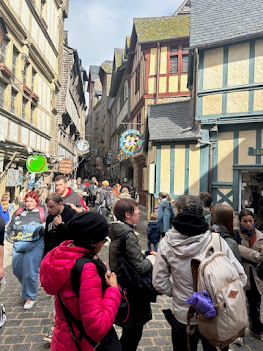Le Mont Saint Michel
The land surrounding this "island" is flat and Mont Saint Michel stands out as you approach from any direction. It is a tidal island where high tides of 46 feet run swiftly and cover the majority of the land surrounding the walls. One can sit on one of the many terrace restaurants and watch the tides splash in creating the island in the time it takes to finish your wine. Begun as a monastery in the 8th century with continuous building into a medieval community, it became a French stronghold in the 15th century never to be captured by the British in the 100 Years War. The soft sands at low tide made it impossible to bring bombards (ancient cannons) into use and the rushing high tide often drowned would be attackers.
It stands 302 feet above sea level with another 200 feet to the top of the church spire, This World Heritage site is the second most visited site in France outside of Paris. I'm on the modern bridge built 10 years ago and even this has been covered during "supertides". When I first came here 35 years ago there was a causeway and car park beneath this bridge. Recently they built a hydraulic dam in order to allow the tides to move freely and flush the silt to again form the island; the car park is now about a mile away and visitors are bussed in and out.
Low tide, you can walk on the sands, but best to do so with a tour guide who knows the tides
My hat kept blowing off.
At the bottom entrance you'll find all the vassals, the subservient workers who were feudal tenants vowing fidelity to their lord landowner.
As you spiral up the walkway you come across the merchants' buildings who still gave their loyalty to the lord but were more independent and thus wealthier due to their need to travel throughout the region and beyond.
Continuing to the top, the houses are for the wealthiest and the feudal lord. Of course, the very top is the church and the clergy who, prior to organized states, really ran the show in Europe.
Crowds even at the end of September
on a cold, windy Friday
Shops, restaurants and hotels are what you'll find here now. There are about 50 hotel rooms, so if you'd like to stay in the summertime get your reservations in early.
The largest houses are at the top below the church. There are about 30 full time residents, a handful of monks and nuns, and the proprietors of the businesses here.










Very interesting Bob! So the layout of the village is in a spiral? There are NO cars in the village, vraiement?
ReplyDelete